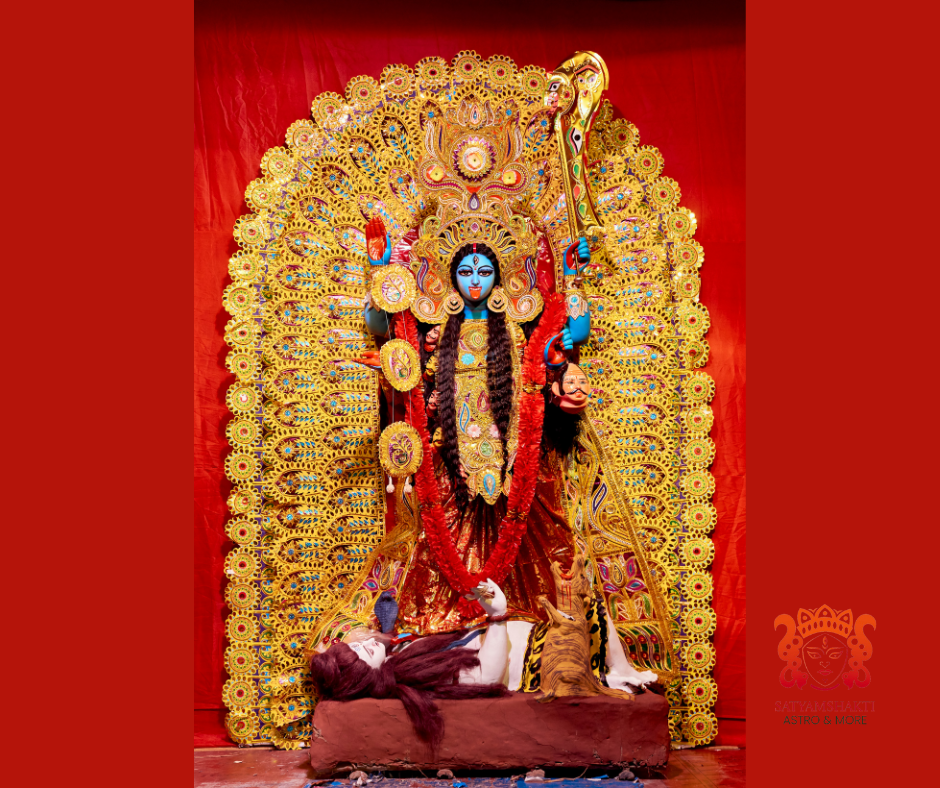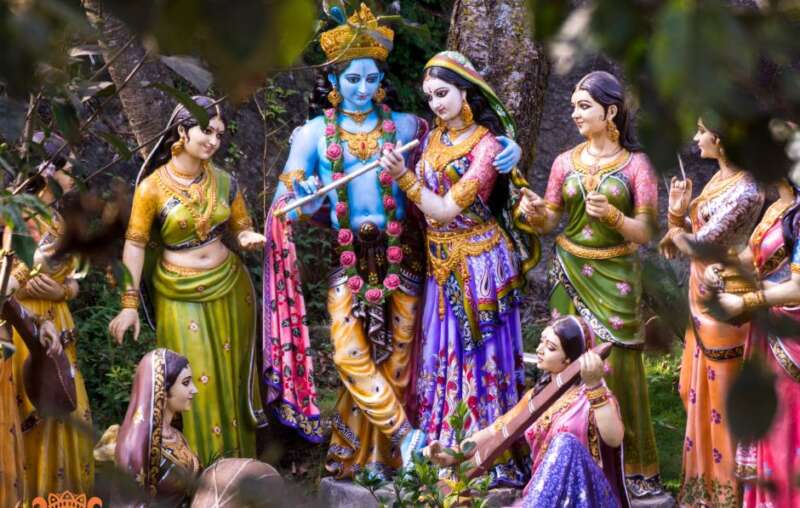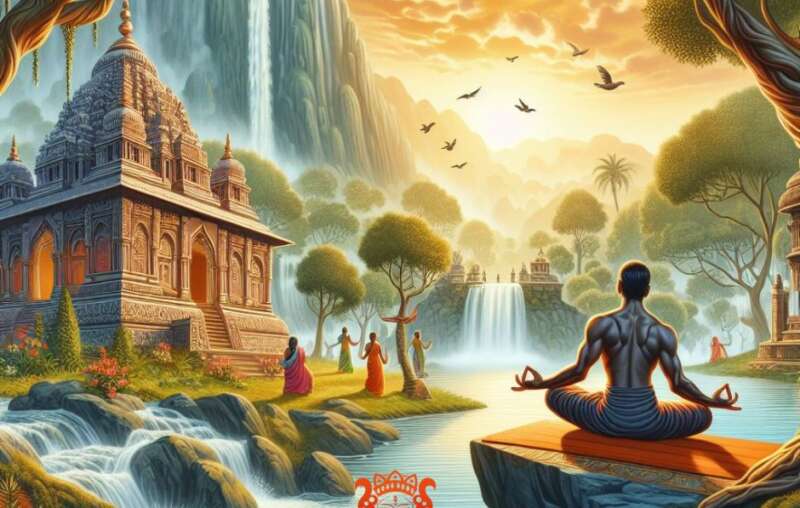Ma Kali’s physical appearance was depicted in Puranas in the manner it has been — the intent was not to appease some misguided modern-day not feminists; neither was the intent to open up opportunity for ignoramuses of today.
(But then, times being what they are, the two situations are playing out today)
The absurdities prevail as does the ignorance about Indian scriptures and ancient Vedic cultures; that people are bringing Ma Kali down to Page 3 type society women of current times.
How many women have you seen around you having four hands? Three eyes? Look and act Like Kaali? So, why is it that people decide to compare Ma Kaali to the women nowadays?
Now, let’s get this clear for once and for all.
Kali was a symbol.
As per Vedic philosophy, Kaali signifies ‘Kaal’.
Kaal has two meanings in Sanskrit:
1. Time. (e.g.—kaal kya hoga)
2. Darkness. (e.g.—Kaala kaaua)
So, why is it that ‘kaal’ signifies the two?
It’s because Time & Space are inseparable entities. (Not my thought alone; its as per Modern Science. Just that our Vedic science understood it ages ago.)
The space is Dark. Hence the time as well is considered Dark. The “Kaala”. Thus ‘kaal’ has two meanings; Darkness, and Time; in Sanskrit—the language of the Vedas.
As per Einstein’s theory of relativity, there is no separate time, and separate space. Time is the Universe’s fourth dimension along with the three-dimensional space. The space is as time is, simultaneously.
Science proclaims as well; there is dark matter and dark energies occupying 95% of the universe. The visible part of this universe is merely 5 %.
Thus the universe consists mostly of ‘darkness;’ not so much light or visible substance.
(Now don’t get me wrong as it’s not what I am saying; Modern Science is saying this. And if you know a bit of Physics, you must have heard of —Space-Time.)
As per Vedic Science, so is the Time which co-exists with the Space.
Kali is said to be the symbol of this time-space; the ultimate structure of the world—and hence it is portrayed as dark; just like space-time in reality is dark.
Now, each matter is related to certain space-time; also, each matter being a condensed form of energy. (E=mc^2, Einstein’s formula of interchangeable nature of matter and energy). This is how, space-time indicates an existence of something; and everything that exists is a form of energy.
So, Ma Kaali, the symbol of Space-Time is also said to be the symbol of energy. ‘The Shakti’.
That’s why Kaali was believed to be the Ultimate Shakti of the universe in Vedic science; and her followers were called “Shaaktas”.
The popular form of Kaali was portrayed as violent and horrific form; as she is the symbol of ‘kaal’, the time; and Time is unforgiving. Time is strict by its nature and all of us are aware of how ruthless time can be. Time takes everyone to the end eventually; it destroys everything, eventually. Time doesn’t care about who you are, how big you are or what your value is, be good or bad; each and everything has an end in the realm of time; and each and everything recedes ultimately in the ever engulfing mouth of the Time.
This is why death pervades everything around Kaali. Decapitated demon heads and blood all around. All symbolize death. The finality or the mortality of everything. Not just of evil but of everything. Just that evil is often first in the line of death.
But what about that tongue sticking out of her mouth, you may ask; the intent is not to get some ill-informed leftist to create a whatsapp emoji; instead it symbolizes that the hunger of Kaali (the time) is never satiated. That tongue is forever ready to gobble up the next death or the next destruction; the next ending of something. (Unlike what some convoluted narrative tells you—that she got ashamed of stepping onto Shiva and stuck her tongue out.) This tongue is a reminder that the hunger of ‘Kaal’ is not satiated yet; and the next person she may savour can be you. In no way can you resist her forever; and in no way can you escape her. And she relishes licking out your death. It’s her duty; as well as amusement.
This is the reason why Kaali’s tongue was portrayed thus in Vedic Scriptures.
She wears no clothing; as Time too shows you the bare reality. Time is rough, tough, rude, and nude. It speaks bluntly. Both good and bad times come without warning; and may go without warning too. It does not know or follow politeness neither does it follow any protocol.
Time has nothing to ‘hide’ from you. Because she knows; eventually, whoever you are, you are all hers.
To round up, just two more questions about the depiction of Kaali.
Why is Lord Shiva is lying under her feet? Also, why is she a woman, not Man.
As per Vedic culture, (contrary to the misinformed narrative); Lord Shiva is said to be the Adi-yogi. He was the first Yogi, the one who created the Yogasutra or the practical method of liberation of soul, and the fundamental basis of Vedic culture or Hinduism. He is the greatest Yogi, eternally; and that’s why all Yogis follow and salute Lord Shiva before starting their Yoga Sadhana.
And among all Saadhanas the highest form is Kaala-sadhana — the Sadhana of Time.
When you are successful in this pursuit; or when you achieve “Siddhi” you can control your time. (As per Vedic concepts). Controlling his/her time is the only reason, an enlightened Yogi can choose his death. Once he/she conquers the time through Saadhana, Time becomes powerless on him/her.
Lord Shiva or Adiyogi under Kaali’s feet symbolizes this fact— every Sadhaka has to surrender himself/herself to the feet of Time to overcome its power. Even Lord Shiva has to be under the feet of Kaali i.e. the Time; and has to do Saadhana for it—to go beyond the power of Time. Time was considered so very powerful by Vedic science. Because, it was the source, the raw material, and also the end—of all creation.
In yogic culture, every Yogi has to surrender to the Lord Shiva before starting his Saadhana. They had to surrender to the Aadi-yogi — who himself surrendered before ‘Kaali’ (the goddess of time), to overpower her. Shiva overpowered time; the highest form of Siddhi for a Yogi—that’s why he is considered the ultimate yogi and the first complete Yogi, i.e. the Aadi-yogi. This is also the reason he is called ‘pati’ of Kaali (or the lord of time); yet he is not called her Swami. Swami means ‘husband’. Pati means Prabhu. The lord. Not the husband exactly. (That’s why when we say ‘Raghupati’; it means the lord of Raghabas, not the Husband of Raghabas.) Lord Shiva mastered the time; that’s why he was called the lord of time or ‘Patidev of Kaali’.
The ancient Indian writers of scriptures developed from this concept a juicy story of romance between Shiva and Kaali, got them married too (as suggested in some stories)—just like journalists do nowadays without understanding the things properly!
So, Lord Shiva is considered as the only one who can overpower time (Pati of Kaali), and that’s why he is the only person who can command it. (For this reason, Shiva is also considered as the God of destruction, as only he has the power to command “Kaali” or the Time. The Kaali or the Time is bound to destroy everything; if Lord Shiva wants—i.e. , if the conqueror of Time wants.
But even he is placed under the feet of Kaali; to symbolize her importance and to emphasise the importance of Time-worshiping in ancient India. That even Lord Shiva has to do her Saadhana first in order to overcome its effect. Only then can he overpower her completely.
This is why Lord Shiva is placed under the feet of Kaali.
Now finally: Why woman?
Because; Time holds each and everything in this universe in its womb. The creation happened only because it has got a ‘time-space’ dimension for it. For anything to exist Time has to produce it by creating a space for it. Time is also the destroyer of the all things; but time also creates everything and holds everything within its eternal flow.
That’s why time is considered as feminine. Time is a female who gives birth to its children, bears it for a while and then takes them back again on her embracing lap. While singing the lullaby of the funeral she gives her children the most peaceful eternal sleep for of their life: the Death.
Life is beautiful; only because it has a time-limit to it. Without the time-limit imposed by death life is a prolonged disaster only.
This is why Time was considered as Mother in Vedic Culture. An energy that is essentially feminine in nature.



